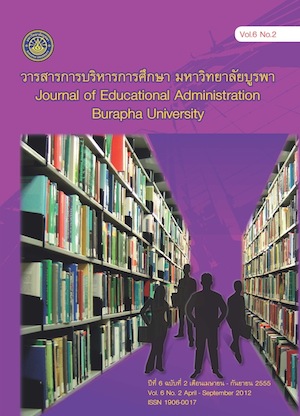การพัฒนารูปแบบการบริหารคุณภาพด้านการอนุรักษ์พลังงาน กรณีศึกษา บริษัท ไออาร์พีซี จำกัด (มหาชน) THE DEVELOPMENT OF QUALITY MANAGEMENT MODEL IN ENERGY CONSERVATION: A CASE STUDY OF IRPC PUBLIC COMPANY LIMITED
Keywords:
การพัฒนารูปแบบการบริหารคุณภาพ, การอนุรักษ์พลังงาน, บริษัท ไออาร์พีซี จำกัด (มหาชน), The development of quality management model, Energy Conservation, IRPC Public Company LimitedAbstract
บทคัดย่อ
การวิจัยนี้มีวัตถุประสงค์ เพื่อพัฒนารูปแบบการบริหารคุณภาพด้านการอนุรักษ์พลังงาน ของบริษัท ไออาร์พีซี จำกัด (มหาชน) โดยใช้รูปแบบของการวิจัยเชิงผสมผสาน (Mixed MethodologyDesigns) ซึ่งประกอบไปด้วยการวิจัยเชิงปริมาณ สำหรับการวิจัยเชิงกึ่งทดลอง (Quasi ExperimentalDesign) ทำการทดสอบก่อน-หลังการทดลองโดยมีกลุ่มควบคุม และใช้สิ่งที่ทดลอง (Treatment) โดยใช้การวิจัยเชิงปฏิบัติการแบบมีส่วนร่วม (PAR) ดำเนินการตามกระบวน การวิจัย ผู้วิจัยได้ร่วมกับทีมวิจัยศูนย์อนุรักษ์พลังงานของโรงงาน ทำการบูรณาการเครื่องมือทางการบริหาร ในการพัฒนารูปแบบการบริหารคุณภาพด้านการอนุรักษ์พลังงาน ตามเกณฑ์เพื่อการดำเนินงานที่เป็นเลิศทั้ง 7 ด้านของรางวัลคุณภาพแห่งชาติ (TQA) การบริหารแบบสมดุล (BSC) กับการจัดทำระบบจัดการพลังงาน (EMS) พัฒนาจนได้รูปแบบ การบริหารคุณภาพด้านการอนุรักษ์พลังงาน และนำไปใช้กับหน่วยงานทั้ง 5 โรงงาน ซึ่งเป็นกลุ่มทดลอง ดำเนินการตามกระบวนการ เสร็จแล้วทำการทดสอบ ประเมินผลลัพธ์ของการปฏิบัติการเปรียบเทียบกับกลุ่มควบคุมอีก 5 โรงงานที่ไม่ให้สิ่งที่ทดลอง โดยมีผู้เกี่ยวข้องให้ข้อมูลตอบแบบสอบถาม สำหรับการทดสอบก่อนและหลังการทดลองกลุ่มละ 45 คน รวมเป็นทั้งหมด 90 คน แล้วทำการวิเคราะห์ผลเปรียบเทียบ โดยใช้โปรแกรม SPSS AMOS V.16 โดยผลการวิจัย พบว่า
1. ผลการทดสอบปรากฏว่า ค่าสัมประสิทธิ์เส้นทางระหว่าง PAR กับ Posttest มีค่าเท่ากับ0.48 ในหน่วยคะแนนมาตรฐาน หรือ 1.06 ในหน่วยคะแนนดิบ สรุปผลได้ว่าประสิทธิภาพของรูปแบบการบริหารคุณภาพของกลุ่มทดลองภายหลังการทดลอง (Posttest) โดยให้สิ่งที่ทดลอง (Treatment)โดยกระบวนการ PAR มีค่าสูงกว่ากลุ่มควบคุม ส่วนกลุ่มควบคุมไม่มีการเปลี่ยนแปลงใดๆ และผลของการทดสอบเป็นไปตามสมมุติฐานของการวิจัยที่ตั้งไว้
2. การทดสอบก่อนการทดลอง (Pretest) มีอิทธิพลในทางบวกต่อการทดสอบหลังการทดลอง เมื่อคะแนน Pretest เปลี่ยนแปลงไป 1 ค่าจะส่งผลให้คะแนน Posttest เปลี่ยนแปลงไปในทิศทางเดียวกัน 0.629 คะแนนดิบหรือ 0.41 คะแนนมาตรฐาน โดยควบคุมกลุ่มทั้ง 2 ให้คงที่แล้วซึ่งผลวิจัยพบว่า ภายหลังการทดลองที่มีการใช้การวิจัยเชิงปฏิบัติการแบบมีส่วนร่วมแล้วจะมีประสิทธิภาพในการบริหารคุณภาพตามรูปแบบมากยิ่งขึ้นเมื่อเปรียบเทียบกับผลก่อนการทดลอง
3. ผลของการพัฒนารูปแบบการบริหารกับองค์การการจัดการด้านพลังงาน โดยบูรณาการเครือ่ งมือทางการบรหิ ารในระบบจัดการพลังงาน (EMS) ที่มี 8 ขั้นตอน การบริหารตามแนวทางรางวัลคุณภาพแห่งชาติ (TQA) ที่มี 7 ด้าน การบริหารแบบสมดุล (BSC) ที่มี 4 มิติ ร่วมกันพัฒนาจนได้รูปแบบการบริหารคุณภาพด้านการอนุรักษ์พลังงาน และผลของการปฏิบัติการแบบมีส่วนร่วมทำให้ได้รูปแบบที่เหมาะสม และพนักงานผู้ปฏิบัติการในโรงงานต่างก็มีความพึงพอใจในคุณภาพของการให้บริการตามรูปแบบเพิ่มมากขึ้น โดยมีตัวแปรแฝงที่พนักงานผู้ปฏิบัติการด้านอนุรักษ์พลังงานในโรงงานมีความพึงพอใจมากที่สุดคือ ด้านการนำองค์การ และด้านผลลัพธ์ของการปฏิบัติการร่วมกันเป็นไปอย่างมีคุณภาพ จึงทำให้มีประสิทธิภาพของรูปแบบในการบริหารคุณภาพด้านการอนุรักษ์พลังงาน ในองค์การของโรงงานมีเพิ่มมากขึ้น
ABSTRACT
The purpose of this research was to study the development of quality managementmodel in Energy Conservation of the IRPC Public Company Limited. This research wasdesigned and applied by using mixed methodology which consisted of quantitative quasiexperimental design. The pretest and posttest were treated on control and treatmentgroups by using PAR process. The researcher along with the research team in the Energy Conservation Center of the plant designed and developed the research tool in the qualitymanagement based on the seven criterions of Thailand Quality Award (TQA), BalancedScore-card (BSC) and Energy Management System (EMS). After completion of formulatedmodel, it was applied to the experimental group in five plants. Then the outcome evaluation was compared with the control group between the pretest and posttest. Thesample consisted of 45 energy operators who were selected from each of the five plantsby means of simple random sampling. The data were collected by seven categories of TQA’s concept and 48 questionnaires. The data were analyzed by descriptive statisticsby using SPSS AMOS Version 16. The research findings were as follow:
1. The results have shown that the path coefficient of SEM between PAR and posttestwere 0.48 standardized score or 1.06 unconstrained score. The meaning of this testdetermined that the quality management model efficiency of the experimental group byPAR showed higher than the control group, but there was nothing changed in the controlgroup. The test results were complied with its research hypothesis.
2. The results of the pretest positively influenced the posttest whenever the pretestscores changed for one unit. It affected the posttest scores to change in the same directionto 0.629 raw score or 0.41 standardized score. It was found that the posttest throughPAR showed more efficiency in quality management as compared with the pretest.
3. The operators were satisfied with the eight steps of the new model of the integrationto quality management model set up from EMS, seven categories of TQA andfour perspectives of BSC. The analysis of latent construction which affected the operators’positive satisfaction. They were impressed with the importance of energy conservationmanagement in leading organization and the results of this research affected directly tothe succession of the development model and showed more efficiency and effectively.


